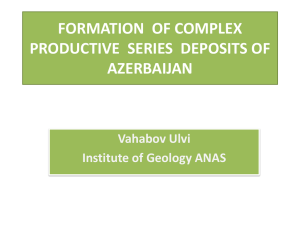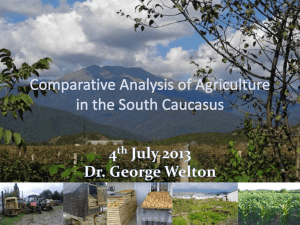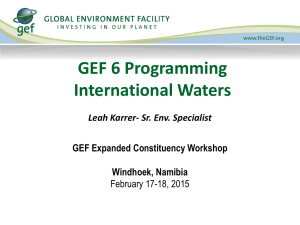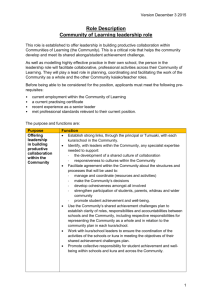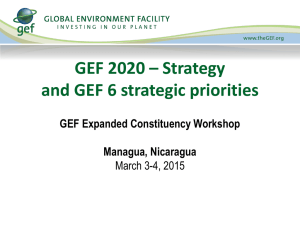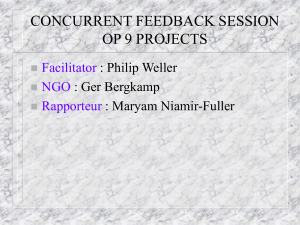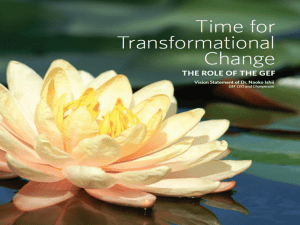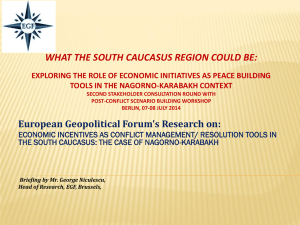Template for a CONCEPT PAPER for a Full Project
advertisement
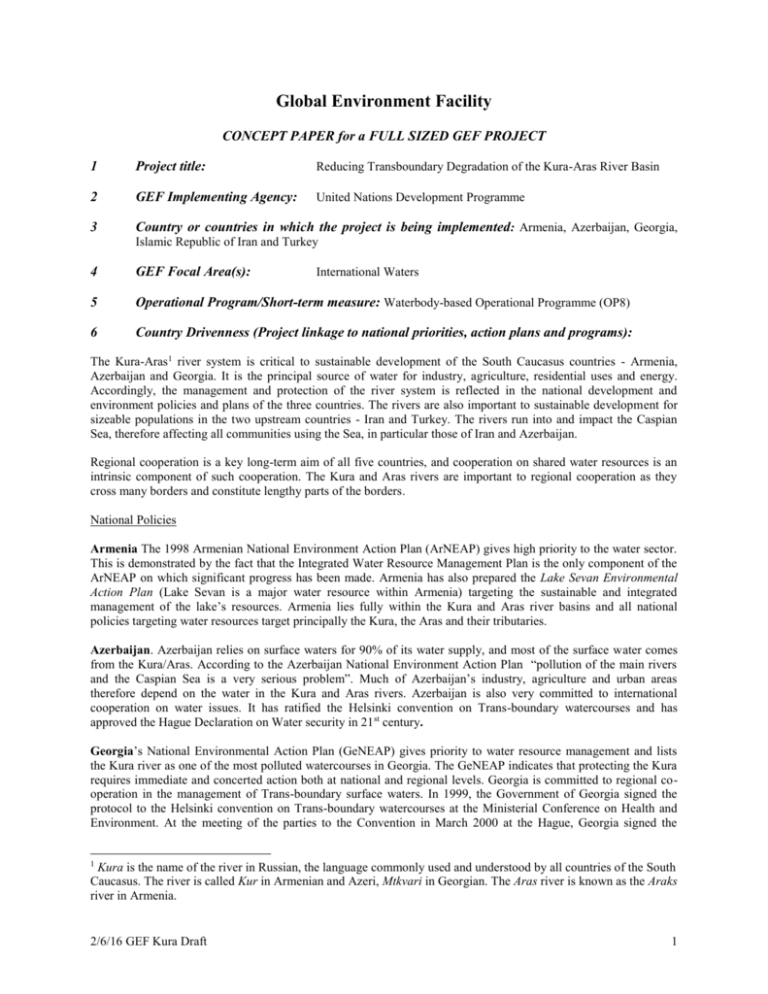
Global Environment Facility CONCEPT PAPER for a FULL SIZED GEF PROJECT 1 Project title: Reducing Transboundary Degradation of the Kura-Aras River Basin 2 GEF Implementing Agency: United Nations Development Programme 3 Country or countries in which the project is being implemented: Armenia, Azerbaijan, Georgia, Islamic Republic of Iran and Turkey 4 GEF Focal Area(s): 5 Operational Program/Short-term measure: Waterbody-based Operational Programme (OP8) 6 Country Drivenness (Project linkage to national priorities, action plans and programs): International Waters The Kura-Aras1 river system is critical to sustainable development of the South Caucasus countries - Armenia, Azerbaijan and Georgia. It is the principal source of water for industry, agriculture, residential uses and energy. Accordingly, the management and protection of the river system is reflected in the national development and environment policies and plans of the three countries. The rivers are also important to sustainable development for sizeable populations in the two upstream countries - Iran and Turkey. The rivers run into and impact the Caspian Sea, therefore affecting all communities using the Sea, in particular those of Iran and Azerbaijan. Regional cooperation is a key long-term aim of all five countries, and cooperation on shared water resources is an intrinsic component of such cooperation. The Kura and Aras rivers are important to regional cooperation as they cross many borders and constitute lengthy parts of the borders. National Policies Armenia The 1998 Armenian National Environment Action Plan (ArNEAP) gives high priority to the water sector. This is demonstrated by the fact that the Integrated Water Resource Management Plan is the only component of the ArNEAP on which significant progress has been made. Armenia has also prepared the Lake Sevan Environmental Action Plan (Lake Sevan is a major water resource within Armenia) targeting the sustainable and integrated management of the lake’s resources. Armenia lies fully within the Kura and Aras river basins and all national policies targeting water resources target principally the Kura, the Aras and their tributaries. Azerbaijan. Azerbaijan relies on surface waters for 90% of its water supply, and most of the surface water comes from the Kura/Aras. According to the Azerbaijan National Environment Action Plan “pollution of the main rivers and the Caspian Sea is a very serious problem”. Much of Azerbaijan’s industry, agriculture and urban areas therefore depend on the water in the Kura and Aras rivers. Azerbaijan is also very committed to international cooperation on water issues. It has ratified the Helsinki convention on Trans-boundary watercourses and has approved the Hague Declaration on Water security in 21 st century. Georgia’s National Environmental Action Plan (GeNEAP) gives priority to water resource management and lists the Kura river as one of the most polluted watercourses in Georgia. The GeNEAP indicates that protecting the Kura requires immediate and concerted action both at national and regional levels. Georgia is committed to regional cooperation in the management of Trans-boundary surface waters. In 1999, the Government of Georgia signed the protocol to the Helsinki convention on Trans-boundary watercourses at the Ministerial Conference on Health and Environment. At the meeting of the parties to the Convention in March 2000 at the Hague, Georgia signed the 1 Kura is the name of the river in Russian, the language commonly used and understood by all countries of the South Caucasus. The river is called Kur in Armenian and Azeri, Mtkvari in Georgian. The Aras river is known as the Araks river in Armenia. 2/6/16 GEF Kura Draft 1 Ministerial Declaration on the principles of integrated water resource management, including the Trans-boundary context. Turkey Water resources management and water quality protection is identified as a priority in Turkey’s National Environmental Action Plan (NEAP, 1998). The main water resource and quality issues identified in the NEAP are: (1) deforestation and poor farming practices leading to erosion, (2) uncontrolled agricultural runoff and discharge of fertilizers and chemical pesticides, (3) large water management projects which if improperly managed can cause population displacement, climatic changes, loss of biodiversity and salinization, (4) diffused responsibility and authority for managing water bodies involving many organizations operating under a variety of laws which reduce effectiveness of water resources management. The Aras river is identified as one of the 26 major water basins in Turkey with a precipitation area of 27,548 km2. Iran The Iranian National Strategy for Sustainable Development identifies the following relevant actions among its list of priority actions and investments: Implementing projects to protect biodiversity…and international water pollution mitigation. Implementing a priority investment programme for “win-win” projects…investments that have both environmental and economic benefits…(such as) projects for watershed and forestry management. Addressing water pollution problems from urban households and industrial sectors through modification of water pricing, institutional framework, and efficient investments…Along with investment preparatory work, water sector studies should be launched and the comprehensive water plan updated. The National Biodiversity Report of the I. R. Iran recognises that managing the rivers that flow into the Caspian is vital to protecting the Caspian Sea ecosystem. The Islamic Republic of Iran has ratified several global and regional conventions including: Convention on Biological Diversity (CBD), Convention on Transboundary Movement of Hazardous Waste (Basel), and is cooperating in regional international waters initiatives in the Caspian Sea and Persian Gulf at present. Sub-regional Policies and Cooperation Following the break-up of the Soviet Union, mechanisms for cooperation, joint water management, and information sharing ceased to function. In 1997, the Ministry of Environment in Georgia took the initiative to promote regional cooperation, notably with the support of the EU TACIS programme. Bilateral co-operation agreements were developed between Armenia and Georgia and between Azerbaijan and Georgia and were signed in 1998 2. Articles 6,7, and 8 of these agreements state an urgent need for the protection of transboundary ecosystems and migratory species. In a related initiative, in 1997, the Hydrometeorological Departments of Armenia, Azerbaijan and Georgia signed a co-operation agreement governing the exchange of information At project, technical and bilateral levels, there is a growing number of inter-country initiatives in the environmental field, including: - the establishment of the Regional Environmental Centre (REC 3); - the GEF MSP Arid and Semi-Arid Ecosystem Conservation in the Caucasus (see later in this document for further details) by Armenia, Azerbaijan and Georgia; - informal cooperation on the USAID funded project South Caucasus sustainable water management project. Turkey has also officially observed some of the activities in this project. See Annex 2 for more information on related inter-country projects 4. The “Agreement on Environmental Protection between Georgia and Azerbaijan” and the “Agreement on Environmental Protection between Georgia and Republic of Armenia”. 3 The REC was established under the Environmental Action Programme for Central and Eastern Europe (EAP) in 1999. Its mission is to assist in solving environmental problems in the Caucasus region by encouraging co-operation among nongovernmental organisations, governments, businesses, and other environmental stakeholders, by supporting the free exchange of information and by promoting public participation in environmental decision-making. The founders are the authorised representatives of the European Commission (DGXI) and Armenia, Azerbaijan and Georgia (their ministries of environment). 2 2/6/16 GEF Kura Draft 2 Despite the above-mentioned agreements and the many projects listed in Annex 2, recent political tensions (between Armenia and Azerbaijan, and between Armenia and Turkey) have limited cooperation in the sub-region. The concerned countries are working to address these political issues, and progress has been made recently. 7 Context Regional Importance of the Waters The Kura-Aras river system is an internationally significant river system, which is seriously degraded and continues to be threatened. Water scarcity is an issue at many points in the river system. Water quality and quantity constraints are already leading to use conflicts, and the trans-border aspects of these conflicts are likely to increase in the baseline scenario. Integrated, multi-country, trans-boundary responses are necessary to address the threats to the river system, and to address their underlying causes. The Kura River originates in the Kizil-Giadik mountain range in Ardahan province in Northeast Turkey, winding its way through mountainous regions in Turkey, Georgia and Azerbaijan into the Caspian Sea. Tributaries flow northwards from Armenia and join the Kura in Georgia and Azerbaijan. The Aras River originates in Erzurum province in eastern Turkey. It flows along the Turkey-Armenia border, along the Iran-Armenia border, along the Iran-Azerbaijan border, before flowing into Azerbaijan where it joins the Kura near the Caspian. Tributaries from Armenia flow south into the Aras. The Aras divides just before meeting the Kura, and one branch flows directly into the Caspian. The total length of the Kura river is 1515km and the total area of the Kura-Aras basin 188 000km2, occupying the greater part of the South Caucasus. This area is distributed amongst the five countries as follows: Iran – 40 000 km2; Turkey – 28.900 km2; Azerbaijan 52.900 km2; Armenia – 29.800 km2; and Georgia – 36.400 km2. The population in this largely mountainous area is approximately 7 million (see Maps in Annex 1). The rivers and their tributaries cover almost all of Armenia and Azerbaijan, and a sizeable part of the populated and urbanized parts of Georgia. The waters in the rivers are therefore essential to sustainable development of these three countries. Whereas they are less crucial, at a national level, to Iran and Turkey, they are nevertheless important to the economy and communities living in the catchment areas. The South Caucasus have been identified by Conservation International (CI) as one of the world’s 25 biodiversity hotspot, and the area identified by CI corresponds closely to the Kura-Aras river system. This demonstrates the ecological importance and fragility of this area. Notably, the Aras is home to one of the last natural sturgeon breeding grounds, there are important and unique dry-land riparine forests along the Kura, and the delta where the Aras and Kura rivers flow into Caspian contains many important wetland sites. The Caucasus region is also well known for its diversity of natural landscapes, climate, unique and ancient cultural heritage, archaeology and ethnography. General Status of the Waters Man’s activities in the second half of the twentieth century had a drastic effect on the quality and quantity of the water in the rivers. A range of factors, including industrial pollution, domestic waste, agricultural pesticides, largescale irrigation/flood control/hydropower schemes and watershed degradation have affected the waters. All countries have contributed to this situation. However, as many countries in the region experienced a significant economic decline in the last decade, the stress on water quality in some parts of the river has decreased temporarily. In the future, as the economies in the region grow, and as some industrial activities are restored, the most likely scenario is that the threats to the water quality will grow. Water quantity problems have generally not decreased in the past decades, with increasing droughts and floods. A good example of how mismanagement can cause irreversible damage to the ecosystem is the disappearance of the Tugai forest in Azerbaijan. Inefficient upstream irrigation systems used the water needed by the forests, and the forests were unable to survive. The further downstream, the greater the water quantity challenges and the deterioration in water quality. This downstream progression is due to the increasing levels and aggregation of pollution emissions, the increasing demands for water, and the fact that the downstream areas are naturally drier. The Kura-Aras rivers also have a 4 The information in Annex 2 was provided by Development Alternatives Incorporated who are responsible for implementing the previously mentioned USAID project. 2/6/16 GEF Kura Draft 3 major impact on the Caspian Sea. At present, the river is the second largest flowing into the Caspian, providing approximately 10% of the total inflow. It is possible that it provides an even greater share of the Caspian’s pollutants5. In order to sustainably manage the Caspian Sea, it will be necessary to manage the quality and quantity of the inflow from the Kura Aras.6 Generally speaking, capacity to manage natural resources in the region is limited. Each country has limited institutions and tools to manage water, and lacks funds due to poor economic performance in recent years. Monitoring and information systems are weak in each country. Each of the countries has a growing but incomplete legislative system to manage water resources, including laws, decrees, guidance, fees and charges. Enforcement levels are mixed. Each country also has a small but growing NGO community, particularly Georgia and Armenia. Previously, the three downstream countries were part of the Soviet Union and since the break-up of the Soviet Union there are almost no mechanisms for regional cooperation. National Contexts Armenia lies upstream on the Kura and Aras Rivers. Armenia has considerable water reserves, both underground, surface and in over 50 man-made reservoirs. Irrigation accounts for an estimated two-thirds of water usage, and water resources are also used for industry, hydropower, recreation, domestic use, and waste disposal. Hydropower accounts for 35% of total energy production. Existing data suggests that Armenia is a source of trans-border pollution on the rivers, notably to Azerbaijan. Armenia experiences regular spring floods due to snow-melts and flash floods which can cause much damage. The floods can flush out sediments in the reservoirs, including deposits of pollutants. Seasonal water shortages contribute to inter-sectoral and inter-district use-conflicts. Lake Sevan, which plays an important role in the national economy, and feeds into the Aras river, has been shrinking in recent years. Management of water and environment is distributed over several agencies, including the Ministry of Nature Protection, the National Environmental Authority, the Hydrometeorological department and others. Coordination amongst agencies is weak and there is institutional confusion, however there is a strong vertical management structure in place. At present, Armenia has weak relations with two of its neighbours - Turkey and Azerbaijan - and this is a barrier to cooperation. However, cooperation on natural resource management does exist, and it is hoped that cooperation on such technical issues as water resources will become increasingly possible. Armenia continues to have good relations with Iran. Azerbaijan is an arid country, totally reliant on water from the Kura-Aras for agriculture, industry and residential use. The rivers also feed many ecosystems in Azerbaijan, including the sturgeon breeding grounds. The present status of the rivers is a real threat to national sustainable development and to these ecosystems. As described by the AzNEAP, “The Kura River (from Georgia) and its tributary (Aras River from Armenia) are already heavily polluted before they cross the border to Azerbaijan. Most flora and fauna cannot survive under these conditions. Municipal and industrial contamination sources and agricultural pesticides from inside Azerbaijan add to the problem. Water from Kura River does not meet Azerbaijan’s drinking water standards, even after conventional treatment.” Despite this latter statement the river is still a main source of water for the nation’s capital, Baku. Water shortages within Azerbaijan are increasingly acute, and are increasingly affected by the regulation of water flow by upstream countries. On leaving Georgia, the river Kura enters Azerbaijan and is immediately stored in the Minchechou reservoir. Vast areas of Azerbaijan are irrigated by this reservoir. Irrigation use may increase following ongoing projects to upgrade 5 Until recently, the Volga was by far the largest pollution source. However, economic decline along the Volga has led to major drops in the pollution load. Ongoing projects funded by USAID, EU-TACIS and GEF (The Caspian Environment Programme – CEP) should provide accurate information on the contribution of the Kura to degradation of the Caspian. 6 The Caspian Sea covers 422,000 km2 and provides a livelihood for 12 million people in five countries. GEF is providing support to the protection of the Caspian through the CEP with the involvement of the five riparian countries and UNDP, World Bank, UNEP and EU-TACIS. 2/6/16 GEF Kura Draft 4 the irrigation system (including a WB project). Pollutants from Georgia also collect in this reservoir, and these pollutants are subject to being flushed out by floods. Due to recent conflicts with Armenia, Azerbaijan is home to a large number of internally displaced persons (IDP). The IDPs create a large pressure on the country’s natural resource base, particularly on riparian forests along the Kura in the north of the country. At the national level, responsibilities for environment and water resources are shared by the newly formed Ministry of Environment and Natural Resources (formed from the previous State Committees for Environment, Geology, Hydrometeorology and the Forestry Agency) and the State Water Committee. Georgia is rich in water resources. It has two primary drainage basins, separated by the Likhi range of mountains. The eastern basin drains into the Caspian Sea, the western into the Black Sea. The Kura is the largest river in the eastern basin. Georgia is also rich in biological diversity due to its highly varied climatic, geologic, topographic, and hydrologic conditions. These conditions allow Georgia to support a biota that includes up to 4,500 species of vascular plants and 10,000 cryptograms together with other organisms. Much of this diversity is found in the Kura watershed, and in the Kura and its tributaries Georgia both contributes to and suffers from degradation of the Kura river. Industrial and domestic untreated waste, coming largely from the Tibilsi region7, severely degrades the water. This is further exacerbated by inefficient agricultural practices (large irrigation schemes and pesticide use). Seasonal but geographically restricted water shortages are increasingly frequent. By the time the water leaves Georgia for Azerbaijan it is seriously degraded. At the same time, a healthy Kura River is essential for an healthy Georgian economy. Georgia depends on the Kura river for industry, agriculture, fishing, energy production and recreation. For example, large areas of eastern Georgia depend on agriculture irrigated by the Kura. Also, some of Georgia’s hydropower (which supplies approximately 70% of Georgia’s electricity) comes from schemes on the Kura. Of the three lower riparian countries, Georgia probably has the strongest institutional and legislative framework. It also has a stronger technical capacity and a developing network of NGOs. Iran A large area of Northern Iran feeds into the Aras river. The Aras accounts for over 350 km of Iran’s northern border, and therefore the area is important for Iran’s relations with its neighbours. The border areas of Iran and Azerbaijan share a common culture, which has facilitated relations between the two countries. Iran has good relations with Armenia. The Government of Iran has a policy to develop hydropower. Details of the plans are still being prepared, but it is considered likely that a large number (up to forty) of small and medium hydropower plants may be built on the Aras river and its tributaries. At present, little is known of the use of this water in Iran, and the status of the water as it runs into the Azerbaijan. These plans are likely to contribute to downstream shortages. Iran is a riparian country of the Caspian Sea and large parts of its population are dependant on the Caspian for industry, agriculture and recreational uses. However, as noted in The National Biodiversity Report of I. R. Iran “polluted rivers threaten the coastal ecosystems… Man-made barriers and obstacles close the migration routes of fishes, and no fish-ways are anticipated along their migration routes, therefore many spawning grounds are destroyed.” Iran is therefore a strong supporter of efforts to improve the quality of the Caspian through the improved quality management of inflowing rivers (notably the Kura-Aras). Turkey The Turkish provinces of Erzurum, Ardahan, Kars and Igdir lie upstream in the Kura-Aras basin. The rivers also make up a small part of Turkey’s border with Armenia. While the environmental situation in these eastern provinces is comparatively good; watershed degradation, erosion and agricultural pollution are issues of concern. Existing data suggests Turkey contributes to pollution levels. Long-term efforts to manage the Kura-Aras would require the involvement of Turkey, and Turkey is keen to cooperate in the region in the long-term. 7 The Rustavili industrial district, just downstream from Tibilsi, is a major source of industrial pollution 2/6/16 GEF Kura Draft 5 8 Project Rationale and Objectives: Objectives The overall objective is to ensure that the quality and quantity of the water throughout the Kura-Aras river system meets the short and long-term needs of the ecosystem and of the communities using the ecosystem. Related to this, a second objective is to improve water quality in the Caspian Sea. The inter-related immediate objectives of the project are: to foster regional cooperation; to increase national and regional capacity to address water quality and quantity problems; to make noticeable improvements to water quality/quantity at points on the river; to develop sustainable financial and institutional arrangements for long-term management and protection of the rivers; and to promote changes in the economic sectors causing pollution, water shortages and habitat degradation. The focus will be on transboundary issues. Threats The water quality in the Kura and Aras rivers is low, gets worse progressively downstream, and is likely to get worse in the future. In terms of quantity, despite many efforts to manage the water flow, areas in the region continue to experience both floods and shortages. These constraints are also likely to grow along with the demand for water in the coming decades. Finally, the Kura contributes greatly to the degradation of the Caspian Sea. All of the major quality and quantity challenges on the rivers have trans-border aspects. Urban and residential threats The 7 million or so people in the river system discharge water and other waste material directly into the river system, with almost no treatment. This problem is widespread across the basin, and tends to accumulate downstream. It is notably important downstream of large urban areas such as Tibilsi, spreading into Azerbaijan. Industrial threats Industry is common throughout the region and is generally old, highly polluting technology. All kinds of industry are found, providing all forms of pollution. All countries also have abandoned contaminated industrial lands, which are likely to release pollution over large time-scales. Although industrial pollution crosses all the borders, the Rustavili industrialised region just downstream from Tibilsi is a major source of pollution for Azerbaijan. Industry is also a major user of water, therefore affecting water quantity. Energy-related threats Upstream countries use dams to generate hydropower. These already affect the temporal flow of water. There are plans to increase hydropower significantly in coming years, notably in Iran (and probably Turkey and Armenia). These plans will clearly affect water in all downstream countries. Agricultural threats Armenia, Georgia and Azerbaijan have large, inefficient and polluting agricultural systems, based on dams and irrigation. Irrigation schemes lead to water loss and lead to salinization, and agricultural systems add pesticides and fertilisers to the water. These problems accumulate downstream, leading to severe water quality and quantity problems as the rivers enter the Caspian. Watershed management Deforestation and land degradation in upstream areas, notably in Turkey, Iran and Armenia, are affecting the quality and quantity of water entering the river. Deforestation is a major contributor to changes in the temporal flow of water, and to the sedimentation flow in the river. Deforestation along the river in Armenia and Azerbaijan is also a major challenge. In Azerbaijan refugees are contributing to the deforestation of unique, biodiversity rich riverside forests. Underlying Causes The above threats to water quality and quantity have many underlying causes, including: At a regional level: Agencies responsible for water management have little incentive to work closely with counterpart agencies in other countries; There is little incentive to ensure sustainability of water quality and quantity that leaves the country; 2/6/16 GEF Kura Draft 6 Government actions and action plans in each country are not coordinated with related actions in other countries; Similarly, efforts by the non-governmental community (the scientific community and NGOs) are not coordinated with efforts in other countries; Private sector activities in one country are not in line with plans and legislation across the border; Standards, legislation and enforcement vary from country to country; Data and information on the water quality/quantity and on absorption capacity is limited, especially at cross-border points. At the National levels: Government agencies do not have capacity to manage water; Inter-sectoral cooperation mechanisms are inadequate; Lack of tools to improve water management within each sector, eg to manage pesticide use in the agricultural sector; In Azerbaijan, internal migration leads to unsustainable utilization of river and riverside resources; Polluters face few incentives to clean up; Underdeveloped legislation and enforcement; Fragmented and very incomplete system of water monitoring and unavailability of reliable data on pollution; Finance and financial mechanisms to clean water or reduce pollution emissions are inadequate; Government and non-governmental actors (NGOs and private sector) do not pool resources. Baseline Scenario The concerned countries recognize the problems and are making efforts to improve water quality. The efforts tend to be fragmented and un-coordinated, and tend to focus on the threats rather than on addressing the root causes. This fragmentation is both within the countries, and across the countries. Given the above underlying causes, it is unlikely that ongoing national efforts would lead to water improvements in the near future; it is more likely that things would get significantly worse before getting better. The international community is supporting efforts to improve the water quality, particularly in the three downstream countries. The international community is also fostering regional cooperation amongst these three countries. Two important planned/ongoing projects include the EU/TACIS Interstate Environment Programme (ISEP) and the USAID Regional Sustainable Water Management project. ISEP is supporting capacity building for monitoring and assessment. This includes the necessary institutional strengthening to improve monitoring 8. The USAID project is working with the three countries on information collection and management (including GIS), on regional political cooperation and on initiating pilot projects. This project initially takes a series of bilateral approaches to strengthening water management capacity. Both of these projects start off with a rapid needs assessment. The absence of Turkey and Iran from other initiatives means that a comprehensive, integrated approach cannot be taken. Even in the three downstream countries, there are no strong tools to foster coordination and cooperation. Even if tools were developed, the capacity in the countries to manage water and to cooperate across the sub-region are insufficient. Notably, information shortages make it impossible to set priorities. Existing initiatives are limited in technical scope, focusing on some aspects but not all aspects of the degradation, and existing initiatives do not take an integrated approach – they focus too much on the threats, not on the underlying causes. They do not aim to initiate the comprehensive set of reforms and investments needed to upgrade water quality. Alternative Scenario The present and planned efforts may slow down the deterioration of the Kura-Aras system. They are not likely to lead to an improvement in the water quality. Without additional support, no effective national or regional 8 This €4 million programme covers four rivers, and starts up in 2001. 2/6/16 GEF Kura Draft 7 management system will be established. Lack of coordination, lack of incentives, will mean that degradation and pollution continue. During the PDF stage, the proposed project will prepare a draft Strategic Action Programme (SAP) which will set solid foundations for a long-term, regional, fully integrated and comprehensive approach to management of the Kura-Aras rivers. Following on from this, the full GEF project will support SAP implementation through a series of policy, institutional and legislative reforms at regional and national level, as well as lending incremental support to key, on-the-ground, pilot projects within the SAP. Regional management mechanisms will be operationalised, and management tools developed. Priority soft and hard investments will be designed and implemented – some incremental investments will be supported by the full GEF project. Sustainable financial and institutional arrangements for long-term management of the rivers will be established, including possibly the mobilisation of public and private sector funding to implement the SAP. Reforms will be initiated in key polluting or withdrawing sectors. The proposed GEF project will build on the findings, information, capacity development and institutional setting of other internationally supported projects in the region, notably the above-mentioned EU/TACIS and USAID projects, and the Caspian Environment Programme 9. The results should be fewer water conflicts, improved water quality on significant stretches of the river, an improved ecosystem and habitat, and biodiversity conserved. Why should GEF get involved at all? The Kura Aras river system is an internationally important waterbody seriously threatened by transboundary threats. Protecting this waterbody is therefore beyond the scope of one country, and will have global benefits. The catchment area is also important in terms of biodiversity, ethnic diversity and political cooperation. Finally, improving the quality and flow of the Kura Aras is essential to protecting the Caspian sea. Governments in the region are committed to cooperate. However, existing mechanisms to operationalise this commitment are limited, and hindered by the tense political situation. GEF support can ensure this commitment leads to action. Specifically, with GEF support, cooperation can lead to joint action and management. 9 Expected outcomes and activities of Full Project: As mentioned previously, the immediate objectives of the project are: (i) to foster regional cooperation; (ii) to increase national and regional capacity to address water quality and quantity problems; (iii) to make noticeable improvements to water quality/quantity at some points along the river; (iv) to develop sustainable financial and institutional arrangements for long-term management and protection of the rivers; (v) and to promote changes in the economic sectors which cause pollution, water shortages and habitat degradation. The focus will be on transboundary issues. The project will be co-financed through baseline and cost-shared incremental funding. The following table identifies likely outcomes and indicative activities for the proposed full project (to be verified during a PDF stage). In the table, activities marked * are not fully incremental and will be co-financed. Co-financing will also be sought for fully incremental activities. Generally, GEF funds will focus on the policy, institutional and legislative measures. Some GEF increment may go to scientific (databases, measurements, monitoring, etc) activities, although much of this should be undertaken by other projects and governments. GEF may support limited data collection, although where possible existing data sources will be used. GEF increment will be provided to pilot on-the-ground demonstration investments. By project end, it is anticipated that GEF will have assisted in establishing a sustainable financial mechanism. Collaboration arrangements will be established with ongoing USAID and EU/TACIS project, in order to leverage support from these projects to both baseline and incremental activities. Additional sources of co-financing, including future USAID and TACIS projects, will be explored during the PDF stage and during full project implementation. 9 The Caspian Environment Programme (CEP), supported by several international agencies including GEF, has its headquarters in Azerbaijan. CEP is a cooperative effort amongst all states on the Caspian to revert environmental degradation in the Caspian. The CEP houses much information on environmental management in the region, and through its network will contribute to the successful implementation of this Kura-Aras project. 2/6/16 GEF Kura Draft 8 An international financial institution (IFI), the EBRD or World Bank, will be involved in resource mobilisation for investments identified through the SAP. 2/6/16 GEF Kura Draft 9 Likely Outcomes At a regional level: 1. A fully approved regional Strategic Action Programme (SAP). This SAP will clarify the overall goals, objectives and responsibilities for basin management. It will clarify coordination and management arrangements. The SAP will determine sources of funding and include a long-term financing plan (the SAP is to be based on the scientific information provided in the transboundary diagnostic analysis (TDA) and the draft SAP which are to be prepared in the PDF stage); 2. Annual, action-oriented, SAP implementation plans. To be approved at the highest government level, these annual plans will set out objectives, outputs, activities, responsibilities, timelines for the year, as well as identifying budget and funding sources; 3. Inter-governmental capacity for transboundary joint water management. An appropriate regional approach to management will be developed, this may be an inter-governmental committee, or river-basin authority, etc. The possibility of an inter-country water management agreement will be explored; In line with the SAP and the first years’ SAP implementation plans: Improved information on the water quantity and quality at key points on the rivers, and on the flow of pollutants along the river; Increased harmonization of legislation, standards and monitoring; Enhanced non-governmental regional capacity: this will cover the technical and scientific community, the private sector, the industrial and agricultural community, and NGOs. The project may facilitate the setting up of networks, information centers, and clearing houses. At a national level: 5. National SAP implementation plans for each country in the basin. Based on the regional SAP, these national plans will cover technical, legislative, financial, economic and scientific activities, and a clear allocation of responsibilities. They will set out priorities, timeframes, milestones and budgets for activities in each country. They will be updated annually; 4. 6. Improvements in water quantity and quality leading to decreased transborder water-related conflicts (in line with the SAP). 7. National capacity for integrated water resource management of the basin. This will include high-level political commitment. Each country should develop appropriate mechanism for in-country management, which feed into and from the regional mechanism. This will include appropriate inter-departmental mechanisms, and mechanisms for NGO and private sector participation in water resources management; Reformed policy, legislative and economic framework, in line with regional and national SAPs, providing incentives for sustainable utilisation of Kura Aras waters; 8. 9. Public, private and international concessional funding to finance water quantity and quality improvement projects in the SAP; 10. Raised awareness, at all levels, including high-level political levels, and strengthened NGO networks; 11. Country specific outcomes 2/6/16 GEF Kura Draft Indicative Activities (some of these activities will commence during PDF stage): (PDF) Undertake TDA and prepare draft SAP* The SAP will include identification of financing mechanisms to implement SAP Appraise and approve SAP Preparation of annual SAP implementation plans, including financing plan (first years’ to be prepared under PDF); Undertake analysis and consultation Draft and approve plan, with secured budget Preparation of detailed feasibility studies to address at least one priority, cross-border, demonstration activity in each country * (PDF) Designing of optimal river basin coordination and management mechanism Establishment of river basin management mechanism and logistical support Training/workshops/strengthening of mechanisms* Conducting regional workshops to bring all the stakeholders together and to facilitate concerted action;* Establish communication and information technology systems, including mechanisms to disseminate and replicate project outcomes;* Implementation of soft elements in the SAP, including monitoring, strengthening monitoring and assessment, training, building data-bases, establishing resource centers, awareness raising, strengthening NGO and NGO networks, strengthening legislation and policies, market based incentive development and revenue generation activities; Undertake analysis and consultation Prepare and appraise implementation plans Working closely with an IFI, preparation of detailed feasibility studies to address at least one priority, cross-border, demonstration activity in each country (this activity to start up during the PDF stage); Mobilise funding In each country, at least one on-the-ground investment to address an urgent cross-border water scarcity or pollution conflict, for example by: integrated management of withdrawals; reducing industrial or agricultural pollution, or; increasing irrigation efficiency. These will serve as demonstration projects – notably demonstrating cooperation and financing mechanisms. * Awareness raising, training, seminars and conference Data collection, data base preparation, information management systems* Analyses and reviews Consultation Prepare proposals for legislation and economic incentives to promote sustainable behaviour in water users and water polluters Regular donor meetings (formal and informal) to mobilise, channel and coordinate donor resources (this activity to start during PDF stage); Business development activities to overcome barriers to private sector funding; Awareness raising, training, seminars and conference* Information and network building* Examples… 10 Study of Minchechou lake quality (Azerbaijan only). Development of a water sharing agreement between Georgia and Azerbaijan; 2/6/16 GEF Kura Draft 11 10 Sustainability (financial, social, environmental) and replicability of the full project Financial From PDF stage and through the full project, the project will address, head-on, financial constraints to addressing water management issues. An IFI will support this aspect of the project. Financing strategies will be a component of the SAP and all regional and national implementation plans. No programme or plan is to be approved if the sources of finance are not defined. As part of these strategies, legislative and market-based approaches to generate revenue, or to provide incentives to stimulate investments into water quality will be explored in each country. Also, the barriers to private sector funding will be assessed and measures implemented for the removal. Donor conferences and meetings will be held in line with resource mobilisation strategies to channel grant and concessional funding towards implementing the SAP. Institutional Sustained government commitment is also essential. Regional government cooperation mechanisms will be established and agreements drawn up to ensure long-term government commitment to the SAP. Project support to non-governmental networks (across the region and in each country) will mean these networks can support implementation of the SAP and maintain pressure on governments. Partnerships and participation are key to successfully implementing the SAP. Key partners include all government agencies, NGOS, scientific community, financial community (private and donor), other donors, GEF and all GEF IAs. Following a stakeholder analysis in the PDF stage, appropriate roles and responsibilities of all partners will be clarified. A regional institutional/management mechanism to ensure long-term continuation of basin-wide management and activities after GEF support is necessary. The PDF will explore alternatives, including the establishment of a river basin authority with a permanent secretariat or an inter-governmental committee. The possibility of managing KuraAras activities within the framework of the Caspian Environment Programme will also be explored. The full project will help establish the management mechanism and support its initial operations. Replicability Successful practices, the findings of the demonstration projects, and the experience on how to finance SAP implementation, can be applied to other projects, rivers and countries in the region. Full project activities will promote dissemination and replication of these practices and lessons learnt to Kura basin stakeholders. For example, this will be done through IW:Learn Phase 2 project and through the River Basin Initiative (GEF-MSP). In addition, the project will exchange lessons learnt directly with related projects in the region (notably USAID and EU-Tacis). 11 Country Eligibility: All riparian countries are eligible for GEF support for International Waters. UNDP has a programme in each country. 12 Stakeholders involved in project: Success in a project of this nature depends on the full involvement of a broad group of actors. During the PDF stage, a stakeholder analysis will be undertaken in each country to determine the public and private sector agencies involved in water pollution and water management. Without pre-empting the findings of that analysis, it is likely that the following institutions and organisations will be involved: relevant ministries and State committees and Departments and their local offices, Parliamentary committees for environmental protection, Hydro-meteorological Departments, etc; local government agencies; water users’ associations, including urban and domestic users; representatives of farmers; representatives of Industries; NGOs, NGO resource centres and Regional Environmental Centre (REC); representatives of the scientific community; donor community and international financial institutions. 2/6/16 GEF Kura Draft 13 Through the stakeholder analysis, for each stakeholder, the present and possible future roles, responsibilities and relationships with water will be clarified. The plan will suggest mechanisms for the optimal involvement of each actor in the full project and follow-up. The stakeholders will be involved in the PDF stage in the preparation of the TDA and SAP. This should generate the buy-in to the process. Through the full project, the stakeholders will benefit from other activities such as studies, workshops, reviews, law and institutional analyses, again helping their buy-in to the SAP and its implementation. During the PDF stage, a broad advisory group will be established with representatives from most of the stakeholders mentioned above. The role of the group will be to advise on project outputs and support project objectives. 13 Information on project proposer: The project proponents are the riparian governments of the Kura Aras Basin and all but Turkey have indicated their abiding interest in working on the project. Signatures will be provided at PDF B submission stage, as is normal in International Waters Projects. The project will be implemented by UNDP and executed by UNOPS. UNOPS will assure neutrality and financial/administrative oversight. UNDP and UNOPS will together ensure appropriate linkages with related GEF and other internationally supported projects, notably relations with the Caspian Environment Programme. To facilitate donor coordination, and to strengthen financial leveraging capacity, an IFI will be engaged to manage components of the full project related to financing implementation of the SAP. This institution may have responsibilities for preparing and hosting donor conferences, for undertaking feasibility and pre-feasibility studies and for developing financial strategies. This institution may already be involved during the PDF stage. A project steering committee will be established, which will consist of one member from each of the concerned governments, UNDP/GEF, the IFI and other donors. The Steering Committee will approve project workplans and major project outputs. Other donors to the project will be represented on the Steering Committee. WB, EBRD, UNEP, EU/TACID and USAID will be invited to observe the meetings of the Steering Committee. 14 Financing Plan of Full project GEF will finance most of the incremental costs of the project. This will include the costs to prepare the SAP, the costs to prepare the first 3 years regional and national implementation plans, and the costs related to implementing soft (policy, legal, institutional) investments. During the PDF, co-financing will be sought to these incremental activities. Co-financing will be sought from governments, from ongoing and future activities under the EU-TACIS and USAID projects (see below), and other projects. GEF will also cover the incremental costs of a small number of strategic demonstration projects. Co-financing will be sought for these on-the-ground activities, and it is hoped that cost-sharing may cover up to 50% of these. Following on from the full project, full implementation of the SAP may require a large number of investments, many large-scale; identification, preparation and financing of such investments will be the responsibility of the involved IFI. GEF may contribute to determining financial arrangements and mobilising finance to these projects, otherwise GEF cannot be expected to contribute to implementing the SAP. The details are to be determined during PDF and Full Project, and it is expected that many other private and public sector will participate in SAP implementation. During the PDF and SAP preparation, close collaboration will be established with the following USAID and EU/TACIS projects, with a view to co-financing activities and mobilising follow-up investments in SAP. - USAID/Strengthening Regional Sustainable Water Management in the South Caucasus. This $4mn project aims to increase the quantity and quality of dialogue between countries in the region, notably Armenia, Azerbaijan and Georgia. The activities and outputs are closely related to the outputs and objectives of the proposed GEF project. Links between the two projects have already been established, and a draft MOU prepared. During PDF B stage, these links will be deepened and areas of cooperation developed. 2/6/16 GEF Kura Draft 14 - EU/TACIS Joint River Management Programme on Monitoring and Assessment of Water Quality on Transboundary Rivers. This €4mn project covers four rivers, including Kura. The overall objective of this Project is to support the prevention, control and reduction of adverse transboundary pollution impact caused by the quality of the four rivers selected for the Project. Although the focus is strongly on monitoring, the project will address related legislative, institutional, economic and financial issues. Information generated and capacity built under this project will be very closely related to the GEF project. 15 IA coordination and Linkages to GEF and IA programs and activities In recent years, a broad body of experience and knowledge with preparing SAPs and enhancing regional cooperation on international waters has developed, much of it through GEF support. The project will build on the experience and findings of the GEF International Waters and other projects, particularly those involved in the preparation of SAPs. Implementation of the Kura Aras SAP will require a variety of support measures and financial mechanisms. Accordingly, as with other international waters projects, implementation of the SAP will rely on good coordination and cooperation amongst the GEF IA and other donors. To ensure this, the IAs and key donors will be involved from the outset and through the process to prepare the SAP. They will be invited to participate in Steering Committee meetings as observers. The project is closely related to the ongoing Caspian Environment Programme – CEP. (CEP involves all countries along the Caspian and is supported by several donors. It provides a strong information, data and technical base, which can be drawn on at both the PDF and full project stages.) During PDF stage, optimal coordination arrangements with the CEP and its coordination centre in Azerbaijan will be determined. In addition, where possible, the project will build on the institutional and informational basis of other regional GEF projects, for example the MSP Arid and Semi-Arid Ecosystem Conservation in the Caucasus. This project involves Armenia, Azerbaijan and Georgia, and aims to develop management plans for arid zones and develop demonstration pilot projects, in the Kura catchment area. This project will generate information and data relevant for the national diagnostic analysis, as well as provide model institutional arrangements at technical and decision-making levels. Another closely related project, implemented by the WB, aims to upgrade the irrigation system in northern Azerbaijan. Possible collaboration with this project will be explored during the PDF. Where appropriate, the proposed project will also be linked to national donor supported project, such as the UNDP Georgia project “Capacity Building for the Ministry of Environment”. 16 Proposed project development strategy A PDF B will be requested for the further development of the project. The PDF B will be implemented over an 18month period, starting early 2002. It is anticipated that the full project brief will be submitted to GEF Council for review in mid-late 2003. The PDF B will establish the project management and decision-making mechanisms. It will also establish necessary advisory and expert support to the decision-making mechanism, for example regional expert groups and national expert teams. The PDF will support a transboundary diagnostic analysis (TDA) to identify and quantify: water scarcity issues; existing and potential water conflicts; pollution sources; hotspots; impacts and; habitat loss. Where possible, the TDA will be based on already available data and information; the EU and USAID projects, which focus on monitoring, should provide important data inputs to the TDA. The TDA will constitute an updated and comprehensive background scientific document to be used as a basis for planning, priority setting and decisionmaking. The TDA will help identify the causal chain to water degradation in the basin and to quantify the root causes. Based on the TDA, PDF B will prepare the Strategic Action Programme for the Kura Aras Basin (SAP may not be formally approved by highest level government in the lifetime of the PDF). The PDF B will also prepare the first of the annual regional SAP implementation plans, and the national implementation plans in each country. The SAP will 2/6/16 GEF Kura Draft 15 also identify one suitable demonstration project for each country, undertake pre-feasibility studies for these10, and set out the steps to implementing these demonstration projects. The PDF will organise at least one formal donor conference. The PDF process is to prepare the SAP and identify financing arrangements, and to operationalise the commitment of the countries to protecting the rivers. The participating IFI will support the investment resource mobilisation and coordination activities in the PDF and in the full project. The PDF will identify possible institutional and management mechanisms needed to ensure sustainable management of the Kura-Aras basis and implementation of the SAP. These may include a regional steering committee, a river basin authority, or linking into an existing inter-governmental authority. The PDF will set out the detailed steps to choosing and establishing the SAP management mechanism. The PDF will also generate the detailed information needed prepare the full project GEF Brief. The PDF will prepare a stakeholder participation plan, it will cost out all activities, undertake an incremental cost analysis and prepare a financial package. 17 Response to Reviews This concept incorporates comments received from GEF and other IA’s when first submitted in July 2001. ANNEXES 1. Maps of South Caucasus region 2. Matrix of Inter-Country projects related to water management in the South Caucasus region 10 The projects should address priority issues, and be suitable for demonstrating financial and institutional mechanisms. The pre-feasibility studies will describe overall benefits and indicate incremental costs and sources of co-finance. 2/6/16 GEF Kura Draft 16 Annex 1.1 Map of South Caucasus Region Showing Approximate Path of Kura and Aras Rivers Arasa 2/6/16 GEF Kura Draft 17 ANNEX 1.1Map showing geographical features of the basin of Kura and Aras rivers 2/6/16 GEF Kura Draft 18 Annex 2 – Matrix of Regional Projects Related to Water Management South Caucasus Regional Water Management Project—USAID Synergy--USAID Energy Linkages Project—USAID Development Alternatives, Inc., Jim Wolf, Team Leader, 946-444 (x 312) Eurasia Foundation, George Zarubin, 923-728 Hagler Bailly, Dean White/Bidzina Chkonia TACIS Joint River Management Programme--TACIS Nato Kirvalidze, tel/fax 966-956, 877-418-171; rec@caucasus.n et South Caucasus Highland and Mountain Development Project—IFAD Center for Highland Development— Mr. Koba Arabuli; 931204; arabuli@globalertl.net Markus Duerst 253-682; tblisi@edc.net 2/6/16 GEF Kura Draft USD 4m began in 1998 USD 400,000 Design and implementation of activities falling under three categories in the Kura and Araks river basins: strengthening of legal and institutional framework for transboundary management; improvement of transboundary water monitoring capabilities; projects that will demonstrate the benefits of inter-country cooperation. Examples of robust 3-country cooperative efforts between NGO/private sector entities. Considering water management in early 2001. Has a glacial melt rate component; Understanding of hydropower’s role. Early spring 2001 (2 years) Regional Environment Center (EU-TACIS, USEPA) Support for South Caucasus Highland and Mountain 2 years (20002002) 1 mln EUR (4 m EUR for all four basins) Chartered 1999 26 mln for Azerbaijan , 23 mln for Georgia USD 500,000 Overall objective is to support the prevention, control and reduction of adverse transboundary pollution impact caused by the quality of the four rivers selected for the project. The results will be used to recommend modifications to the UN/ECE Guidelines for monitoring and assessment of transboundary waters. Emphasis on capacity building and the development of regional environmental cooperation. Objectives include increasing information exchange between NGOs, governments, the scientific community and the private sector, developing compatible environmental policy and strategies among countries, and raising awareness about the environment. Includes a grants program. Rural infrastructure rehabilitation, including irrigation; center to be established in Azerbaijan (see Azerbaijan project matrix) Possible grant support to IFAD project 19 Development Project—Swiss Agency for Development and Cooperation Arid and Semi-Arid Ecosystem Conservation in the Caucasus (CASEC) GEF/UNDP (grant) Biodiversity portfolio for the Caucasus MacArthur Foundation TEAP—TACIS Environmental Awareness Project Kura-Araks Coalition NACRES, Zurab Gurielidze, Levan Butkhuzi Tel.: 8-99-56-8032 December 1999; 24 months USD 750,000 (plus 128,000 in kind) The objective of this project is the protection of biodiversity in the arid and semiarid zone in Eastern Georgia. The project is designed to ensure local land users’ participation in the design of alternative land uses, and their integration in its implementation. The project will complement and enhance proposed protection activities in the target area and coordinate these with neighboring countries (Azerbaijan and Armenia) sharing sections of the ecosystem. 1999-2000 80,000 Prioritization of activities in the region in biodiversity field. Completed. Keti Chachibaia, 998-558 WWF-Georgia Nugzar Zazanashvili 33-01-54 completed NGO Little Town--Gocha Dzamukasvili (899) 572-143 1997 Caucasus Environmental NGO Network USAID DevTech Systems/ Georgian Center for the Conservation of Wildlife 1999-2000 Peace Zone project— Helsinki Citizens’ Assembly Arzu Abdullayeva, 994-12-413676; assemblybaku@azeurotel .com Cooperative River Monitoring among Armenia, Azerbaijan, Georgia and the National Academy of Sciences (Armenia), Coalition of NGOs from all three South Caucasus republics focusing on the Kura and Araks basins. Conduct public awareness raising and monitoring. 58,000 Promotion of the regional environmental collaboration in the Caucasus by information exchange (monthly bulletin “Caucasus Environmental News” and listserves) and regional workshops in separate subjects. A project for a Peace Zone in the 'Red Bridge' area where Armenia, Azerbaijan and Georgia meet. Local groups in the area will jointly campaign for a series of steps which could help to remove tension: - partial lifting of the Azerbaijan blockade on Armenia in the local Kazakh-Ejevan area - withdrawal of military forces to ten kilometres inside each country - de-mining - independent radio and television links between two countries - joint projects on infrastructure, especially concerning water and agriculture - people-to-people contacts. http://www.hca.cz/projects/baku.html) 2/6/16 GEF Kura Draft 3 year project; June 2001 Pre-proposal has been submitted to NATO. Purpose of demonstration project will establish approximately 90 monitoring stations for collection of limited data above and below major cities and farming, mining and industrial areas on the Kura and Araks Rivers and their major tributaries. 20 US—NATO Science for Peace Programme Tbilisi State University (Georgia), and Azerecolab (Azerbaijan) This system will be developed cooperatively with scientists from Armenia, Azerbaijan, Georgia and the US, and with additional funding from the US DOE. Italicized descriptions indicate that projects are in the conceptualization stage. 2/6/16 GEF Kura Draft 21
